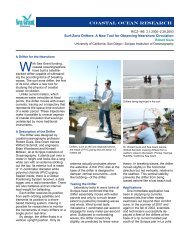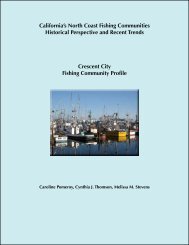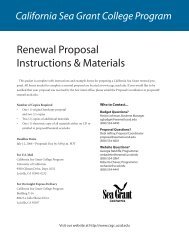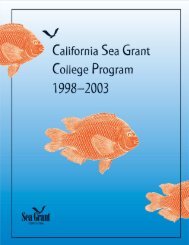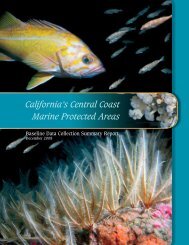2001â2002 - California Sea Grant - UC San Diego
2001â2002 - California Sea Grant - UC San Diego
2001â2002 - California Sea Grant - UC San Diego
Create successful ePaper yourself
Turn your PDF publications into a flip-book with our unique Google optimized e-Paper software.
A technician radios scientists to tell them he has recovered a<br />
drifter. Photo: Georgia Ratcliffe, <strong>California</strong> <strong>Sea</strong> <strong>Grant</strong><br />
engineers and technicians successfully deployed a fleet of 10 drifters at the<br />
base of a rip current located about a quarter-mile south of the Scripps pier.<br />
The drifters’ paths revealed a never-before-measured feature of the surf<br />
zone, large eddies (circular currents) at either side of a rip. Swirling waters<br />
have been reported anecdotally, predicted by ocean theoreticians and<br />
suggested in some numerical simulations, but this was the first time<br />
researchers had actually measured them.<br />
By overlaying drifter trajectories on maps of bathymetry, the scientists<br />
have also been able to discern a connection between the shape of the<br />
seabed and the location of rip currents.<br />
The width of the surf zone seems to exert some control over rip currents,<br />
as the scientists reported the drifters accelerated as they traveled<br />
seaward. They<br />
reached a maximum<br />
speed at the edge of<br />
the surf zone—some<br />
two to three times<br />
faster than average.<br />
Width may also play a<br />
role in determining<br />
the seaward extent of<br />
a rip current.<br />
A second deployment<br />
of the drifters<br />
was repeated in the<br />
summer of 2002<br />
along the same<br />
stretch of beach as the<br />
year prior. The<br />
scientists have not yet<br />
analyzed the data, but<br />
it will be a key part of<br />
Schmidt’s doctoral<br />
thesis, “Spatial and<br />
Temporal Variability<br />
of a Rip Current.”<br />
By some accounts, rip currents are the cause of 80<br />
percent of all distressed swimmer rescues. Often<br />
erroneously called undertows, rip currents do not pull<br />
swimmers down, but carry them offshore through the<br />
surf zone. If caught in a “rip,” the swimmer should<br />
not panic, but swim calmly parallel to the shore. Rip<br />
currents are narrow and can be escaped easily in<br />
this manner. Illustration: North Carolina <strong>Sea</strong> <strong>Grant</strong><br />
19



